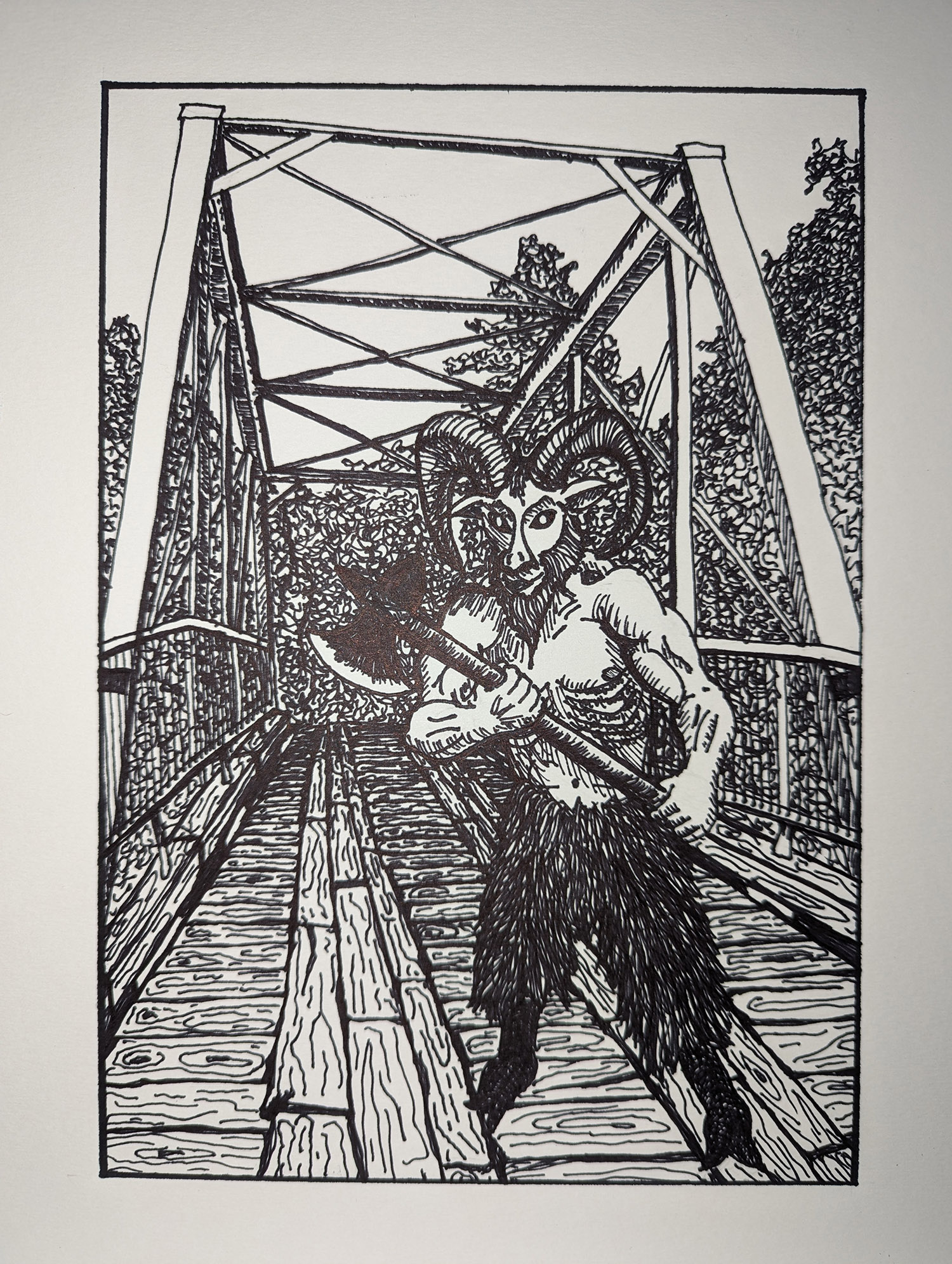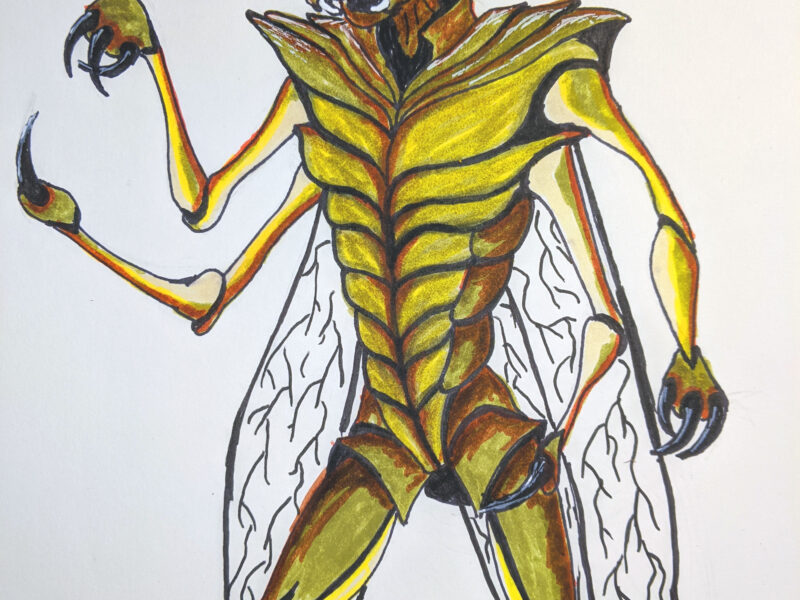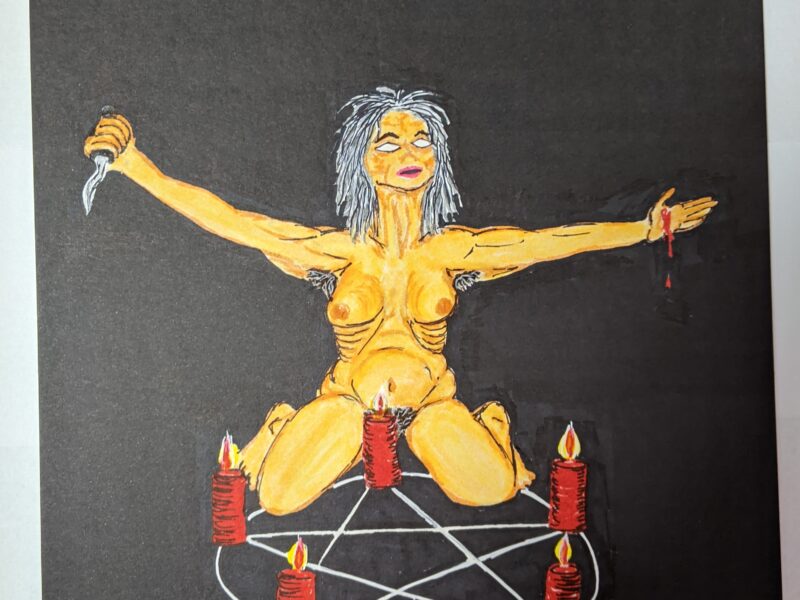Pen and Ink 9×12 on 140 lb watercolor paper.
Sometimes when I draw monsters and other creatures its just letting my imagination go. Other times I am exploring for other reasons. This one resulted from my work documenting cryptids for Relevant Irreverence. It was a lot of fun to draw, and I really like the drawing so I am releasing it in both places at once.
Here is some background on the subject at hand.
Half-Man, Half-Goat Hybrids: Cryptids and Artistic Influence
Cryptids:
- Goatman (Maryland, USA):
- Origin: The legend of the Goatman emerged in the 1950s in Prince George’s County, Maryland. He is often described as a half-man, half-goat creature, allegedly the result of a scientific experiment gone wrong at the Beltsville Agricultural Research Center.
- Sightings: Reports typically involve the Goatman attacking cars, killing pets, and lurking in the woods. One famous sighting from the 1970s describes him attacking a car with an ax.
- Behavior: The Goatman is characterized by aggressive behavior, often chasing or frightening people who venture too close to his territory.
- Lake Worth Monster (Texas, USA):
- Origin: Sightings of this creature near Lake Worth, Texas, were first reported in 1969. The creature is often described as a goat-like humanoid, sometimes covered in scales.
- Sightings: Witnesses have reported the monster throwing tires and other debris at them. A well-publicized sighting involved the creature jumping onto a car.
- Behavior: This cryptid is known for its menacing behavior, often frightening onlookers with its aggressive actions.
- Pope Lick Monster (Kentucky, USA):
- Origin: This creature is said to inhabit the area near the Pope Lick railroad trestle bridge in Louisville, Kentucky. The legend blends elements of a goat and a human, with some versions claiming it is a goat-human hybrid resulting from a freak accident or scientific experiment.
- Sightings: The Pope Lick Monster is often blamed for luring people onto the train tracks, leading to fatal accidents.
- Behavior: It is said to have hypnotic powers or a voice that can mimic loved ones, drawing victims to their doom.
Artistic Influence:
- Greek and Roman Art:
- Satyrs and Fauns: These mythological beings have been a significant subject in ancient art. Greek pottery, mosaics, and sculptures often depict satyrs in playful and hedonistic scenes, reflecting their association with Dionysus, the god of wine and revelry. Fauns are similarly depicted in Roman art, often shown in pastoral settings.
- Sculpture: Famous sculptures, such as the “Sleeping Faun” and the “Dancing Satyr,” showcase the blend of human and goat features, emphasizing their connection to nature and wildness.
- Medieval and Renaissance Art:
- Baphomet: Often depicted in medieval and occult art, Baphomet represents a complex symbol blending human and goat elements. Eliphas Levi’s 19th-century depiction of Baphomet, featuring a humanoid figure with a goat’s head, wings, and various esoteric symbols, has had a profound influence on occult iconography.
- Krampus: In Central European folklore, Krampus has been depicted in various forms of art, including woodcuts, postcards, and holiday greeting cards, particularly during the Christmas season. These images often emphasize his goat-like features and menacing appearance.
- Modern and Contemporary Art:
- Pop Culture: The Goatman legend has influenced various forms of modern media, including literature, movies, and comics. These stories often explore themes of scientific hubris, the clash between civilization and nature, and the fear of the unknown.
- Illustrations and Comics: Artists and illustrators have used the imagery of half-man, half-goat beings to evoke mystery and horror. For example, the Goatman often appears in horror comics and graphic novels, reflecting the enduring fascination with cryptids and urban legends.
- Fantasy Art: In contemporary fantasy art, goat-like humanoids frequently appear as mythical creatures or characters in role-playing games, video games, and fantasy novels. They are often depicted with intricate details that emphasize their otherworldly nature.
Conclusion: Half-man, half-goat hybrids have a rich history in mythology, folklore, and art. From the ancient depictions of satyrs and fauns to modern cryptid legends like the Goatman, these creatures continue to captivate human imagination. Their representations in art, both historical and contemporary, reflect deeper cultural themes about nature, humanity, and the supernatural. Whether as symbols of hedonistic revelry, guardians of nature, or menacing cryptids, these hybrids hold a unique place in the collective consciousness, blending the boundaries between the human and the animal.



